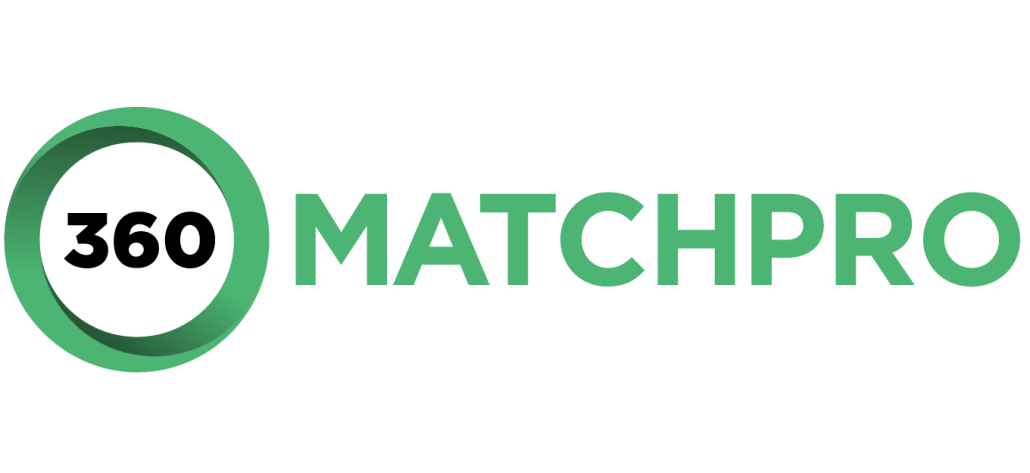Corporate Insights: The Ultimate Guide to Workplace Giving
Workplace giving is a popular—and continuously growing—initiative where corporations equip their employees to support a wide range of nonprofit causes. And in most cases, the businesses give right alongside their team members.
If you’re looking to incorporate this type of philanthropy into your own business practices, you’ve come to the right place. This comprehensive workplace giving guide will share everything you need to know as a business leader to become a top provider in the corporate giving sector.
Here, we’re going to walk through the following essential topics:
-
- What Is Workplace Giving for Companies?
- Workplace Giving vs. Corporate Philanthropy
- Common Types of Workplace Giving For Companies
- Benefits of Workplace Giving for Companies, Nonprofits, and Employees
- Examples of Companies With Great Workplace Giving Programs
- How Companies Can Get Started With Workplace Giving
As more and more companies prioritize corporate social responsibility (CSR), the need to become a competitively giving business grows as well. Luckily, workplace giving is an impactful (and relatively easy) way to do so.
Whether you’re aiming to launch a workplace giving initiative at your business for the first time or improve upon existing programming, these tips, tricks, and basic knowledge will help. Let’s begin!
What Is Workplace Giving for Companies?
Workplace giving campaigns are employer-sponsored programs that allow employees to make charitable contributions via payroll deductions, matching gifts, corporate volunteerism, and similar methods.
Also known as employee giving, this CSR strategy allows companies to align their charitable giving with their employees’ philanthropic values. The goal is to offer a convenient and structured way for employees to support nonprofits, thus enabling companies and their workers to make a positive impact through their everyday work.
Workplace Giving vs. Corporate Philanthropy
Workplace giving is essentially a subcategory of corporate philanthropy—and a major one at that.
All workplace giving is corporate philanthropy, but not all corporate philanthropy is workplace giving. Think about corporate philanthropy as one big puzzle. Different types of workplace giving are only part of that puzzle!
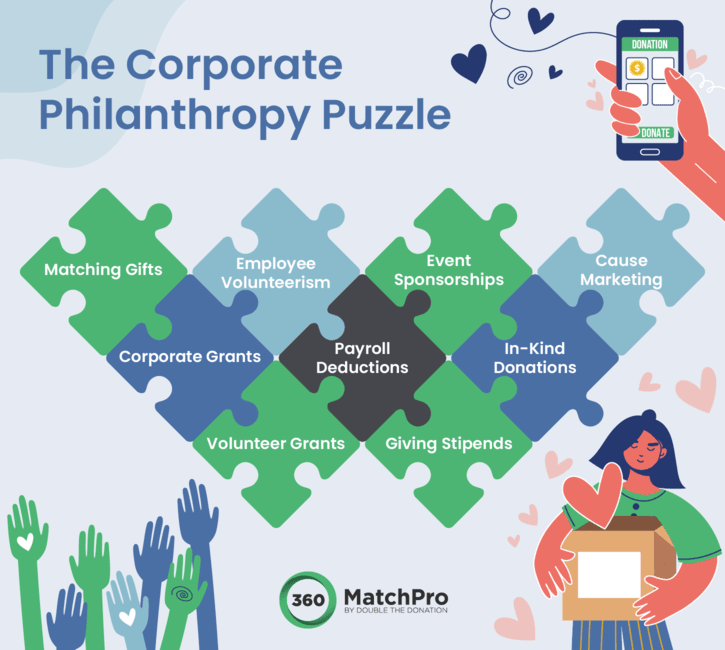
So what’s the difference? Let’s dive into the two topics.
Workplace giving
The most significant difference between workplace giving and corporate philanthropy is that workplace giving places a company’s employees in the driver’s seat. In these scenarios, team members actively participate in their employing company’s philanthropy.
For example, companies participating in workplace giving initiatives enable employees to choose nonprofit recipients to which revenue will be directed, drive higher amounts of revenue toward charitable causes, and more. These variables typically depend on the employee taking a particular action, such as donating or volunteering with an organization.
Corporate philanthropy
Corporate philanthropy, on the other hand, is any act of charity conducted by a business—whether its employees have a say in the process or not.
Examples of this might include a business writing a multi-million-dollar check to a single organization, partnering with a nonprofit cause to sponsor an event or fundraising campaign, or agreeing to donate free or heavily discounted products distributed by the company.
These initiatives are still great but have less of a direct correlation with the company’s employees on a smaller scale.
Common Types of Workplace Giving For Companies
Workplace giving comes in many shapes and sizes. The ones you choose to implement should ultimately reflect the company’s goals and employees’ preferences—and locate where the two ideas overlap. Let’s explore a few of the most-used types of workplace giving programs (and how they work).
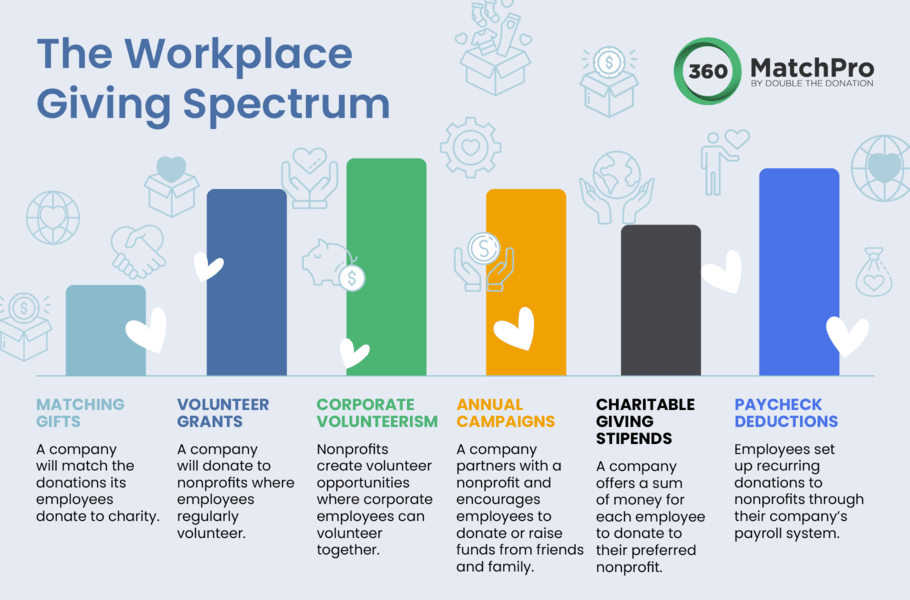
Matching Gifts
When your company offers this type of employee giving program, you’ll financially match the donations employees make to various qualifying nonprofits. This is the most sought-after type of workplace giving for companies, with 84% of employees saying they’re more likely to donate to charity if a match is offered.
Here’s a quick overview of the process:
- One of your employees donates to a nonprofit.
- Using a matching gift database, they research your company’s matching gift guidelines.
- If eligible, they fill out a form with details about their gift.
- Your company confirms the donation with the nonprofit and sends a grant to the organization.
Double the Donation’s matching gift auto-submission removes a few steps from this process, which we’ll explore later. Employees won’t have to manually check their eligibility or fill out a form when using this feature.
In any case, you’ll need to set participation qualifications. That includes rules for employee eligibility, nonprofit eligibility, match ratios, minimum and maximum donation amounts, and deadlines for employees to request a match. For example, you might say that full-time employees’ donations between $25-$1,000 to any registered 501(c)(3) organization are eligible for a 1:1 match. As long as they submit a matching gift request within one year of their donation, your company will send a check that’s the same amount as the initial donation.
You can also go with custom matching gifts to be slightly stricter on the causes your company will support. With this type of workplace giving program for companies, you’ll only match employees’ gifts to a select organization. For example, your company might only match donations to a breast cancer research organization for the duration of Breast Cancer Awareness Month.
Volunteer Grants
This type of workplace giving for companies is pretty similar to matching gifts. With a volunteer grant program, your company will provide a monetary donation to an organization in response to an employee volunteering their time with the cause.
For example, let’s say your company offers $20 for every hour employees volunteer. After learning about the program, one of your employees volunteers for 10 hours with a nonprofit and submits a request to your company. You’ll confirm the volunteer hours and then send a grant of $200 to the nonprofit.
Paid Volunteer Time Off
Another type of workplace giving program your company can offer is known as paid volunteer time off, or VTO. In this scenario, you’ll supply employees with a set amount of hours they can take each month, quarter, or year—on top of existing paid time off allotments. Employers generally implement between 8 and 40 hours on an annually recurring basis, with employees able to use that time to participate in volunteer activities for their favorite organizations.
Corporate Volunteerism
Nonprofits often organize group volunteer opportunities or events that a company signs its staff up for. Sometimes, companies like yours can reach out to these organizations to initiate these opportunities. Employees work together to help out the organization, the nonprofit receives additional assistance, and the company sees positive benefits from team-building through company volunteerism.
Annual Campaigns
For this employee giving initiative, your company can partner with a nonprofit organization to organize and host a team-wide fundraising campaign for a cause its employees care about. Employees work together to raise funds for the campaign and perhaps participate in a fundraising event as well.
For example, you might ask employees to raise money for a nonprofit’s upcoming 5K run by soliciting donations from their own friends and family members. Or, maybe your company wants to run a holiday toy drive for a local children’s organization. You can set up donation boxes around the office, and employees can drop off toys over the course of a few weeks. Then, your company can load them up and drop them off at the nonprofit.
Employee Grant Stipends
Some companies offer a lump sum of money for each employee to donate to the nonprofit cause of their choice. Funding comes from the company rather than employees’ own wallets, but team members have the ability to designate funding to charitable missions that they care about. These are also sometimes referred to as “charitable gift cards” and are used as rewards for top job performance.
For example, your company might give each employee a credit of $100 to contribute to their favorite charity each year. This is a great way to get involved in workplace giving while giving employees the power to direct the funds.
Paycheck Deductions
Typically managed through a company’s payroll or HR system, paycheck deductions enable employees to quickly and easily set up recurring donations to preapproved nonprofits. And it all happens behind the scenes before the dollars have even hit the individual’s wallet.
Now, employees have the choice to give to a range of organizations. For instance, an employee might set up a $50 automated donation directly from their paycheck each month.
Pro Tip: If you’re getting started with workplace giving for the first time, we suggest choosing one or two programs above to implement at your company. As you develop and troubleshoot those initiatives, feel free to add more employee giving opportunities down the line.
Benefits of Workplace Giving for Companies, Nonprofits, and Employees
In a time when employees and customers care more than ever about how companies interact with their communities, CSR programs like workplace giving are on the rise. But do these programs really work? Does workplace giving provide substantial enough benefits for businesses, nonprofits, and employees to be worth investing in?
The short answer is yes! There are tons of benefits to workplace giving programs, from the perspectives of both the nonprofit receiving funding and the company contributing charitably—not to mention the employees participating.
Let’s dive deeper to find out exactly how these programs are valuable, and why your company should get involved.
Why Workplace Giving Matters for Companies
Workplace giving programs offer many of the same benefits that traditional corporate philanthropy and overall CSR do. However, companies tend to see even more direct and impactful results from workplace giving, especially when it comes to internal outcomes among their staff, by placing employees at the center of their efforts.
In terms of workplace giving benefits for companies, these are some of the top advantages you might see:
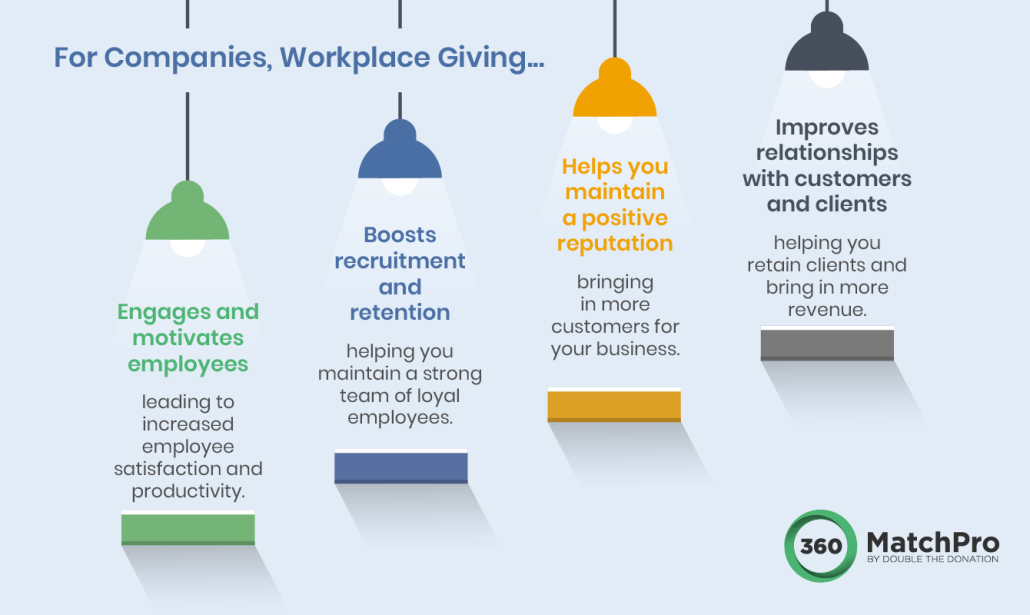
1. Engaged and Motivated Employees
Most employees appreciate any kind of corporate philanthropy because it shows that your company cares about its community and is committed to creating positive change. However, workplace giving programs in particular are uniquely engaging since they put employees in the driver’s seat of giving.
By letting employees choose the nonprofits you donate to, your company invests in the causes that are closest to your employees’ hearts. Supporting the nonprofits and causes that team members care about most can engage employees, motivate them to be more productive at work, and increase their overall job satisfaction.
After all, today’s employees want to be proud of the companies they work for. When your staff knows you prioritize philanthropy—and particularly support the organizations they care about—they’ll be more likely to be engaged in their role. And with engagement comes higher levels of productivity, happier employees, and lower absenteeism rates. In fact, highly-engaged workforces see 43% lower turnover rates, 14% more productivity, 43% fewer absences, and 68% higher well-being.
2. Boosted Recruitment and Retention
Employees prefer working for charitable-minded businesses. By highlighting workplace giving opportunities to team members, companies often see higher rates of retention and overall lengthier tenures.
Along with engaging existing employees, workplace giving opportunities can also help you recruit and retain new applicants, empowering you to maintain a strong team of loyal employees at your business.
Take a look at these two statistics provided by ZipDo that showcase this benefit:
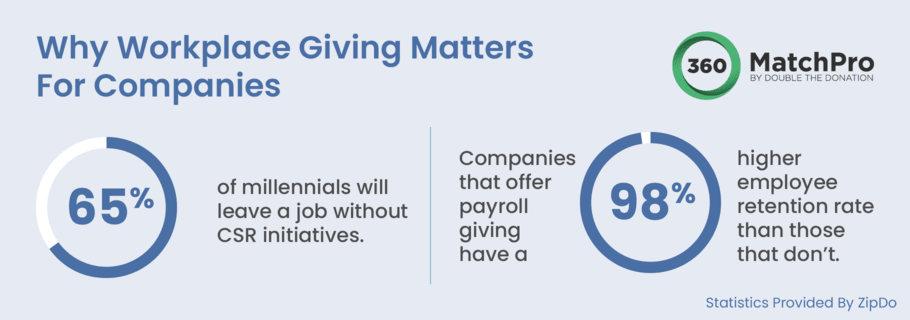
- 65% of millennials will leave a job without CSR initiatives.
- Companies that offer workplace giving via payroll deductions have a 98% higher employee retention rate than companies that don’t.
From these statistics, it’s clear that employees care about workplace giving and other CSR programs and that these initiatives impact how long they stay with a company. By developing workplace giving programs that resonate with employees, you can recruit and retain more team members over time.
Meanwhile, companies that enable payroll giving have a 98% higher employee retention rate than those that don’t. And the same positive outcomes apply to recruiting!
3. Positive Reputation
Another one of the top benefits of workplace giving is that donating to nonprofits helps your company maintain a positive image as a socially conscious company and a good corporate citizen. How? CSR focuses on companies that positively impact the world, typically through corporate philanthropy, ethical labor practices, environmental leadership, and more. Because workplace giving falls within corporate philanthropy, it’s a great way to boost your social responsibility—and thus, elevate your reputation among consumers.
Remember: your company’s reputation impacts the way your business is seen by the community, the media, customers, and employees. By boosting yours with meaningful workplace giving programs, you can establish more positive relationships in the community and bring in more customers.
4. Improved Consumer Relationships
Customers want to buy from companies that invest in their communities. Take a look at two statistics from Double the Donation that demonstrate the connection between customer relationships and CSR programs like workplace giving:
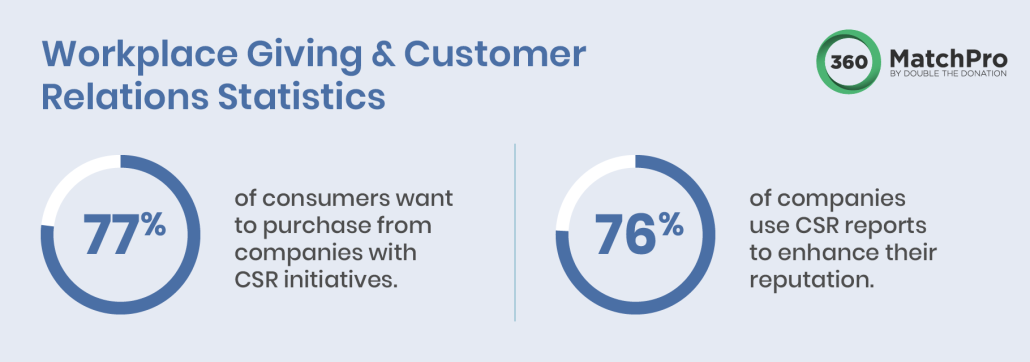
- 77% of consumers want to purchase from companies with CSR initiatives.
- 76% of companies use CSR reports to enhance their reputation.
Launching workplace giving programs allows you to demonstrate your commitment to CSR and community investment, helping you retain customers and ultimately bring in more revenue for your business.
5. Access to exclusive tax benefits
A significant motivator for many kinds of corporate philanthropy is the tax benefits—specifically the deductions that allow a company to reduce its gross taxable income.
In this scenario, workplace giving can be especially beneficial. For example, matched donations can lead to tax deductions above and beyond the typical 10% limit compared to total annual revenue. The more a company can reduce its taxable income, the less it has to pay in annual taxes.
Why Workplace Giving Matters for Nonprofits
Of course, companies aren’t the only ones that benefit from workplace giving. The nonprofits that get donations through workplace giving programs also receive:
1. Increased fundraising revenue
Not only do nonprofits earn donations from the companies themselves, but they can also receive larger gifts from supporters. According to a recent study, 1 in 3 donors say they’d give a larger donation if they knew it would be matched by their employer.
2. More engaged donors
Workplace giving programs allow donors to make more of an impact without putting any added pressure on their own wallets. This makes it easy for nonprofits to engage donors in fundraising and strengthen these important relationships.
3. Potential for lasting partnerships
If a nonprofit has multiple donors who work at the same company, this can open the door for larger, mutually beneficial partnerships between the nonprofit and the company. Consider pitching a direct sponsorship or a custom matching gift program as a way for the business to grow its support of your cause alongside its employees’ generosity!
Even though companies and employees are the drivers of corporate giving, there’s still plenty that nonprofits can do to get one step closer to accessing these benefits.
Why Workplace Giving Matters for Employees
What about employees? Are there any major benefits of workplace giving for the team members who participate in your programs?
The answer, again, is yes! Workplace giving programs increase trust in the company and contribute to an overall more positive company culture. When employees can clearly see that their employer acknowledges and supports their charitable interests, their relationship with the company improves.
Unsurprisingly, this positive company culture can result in greater retention, too. Employees are happier at philanthropic companies, so businesses that engage employees in doing good tend to see an average of 57% lower turnover.

Additionally, workplace giving enables employees to easily make more of an impact on their favorite nonprofits, increasing the value of their contributions to the causes they care about.
Examples of Companies With Great Workplace Giving Programs
As you begin exploring workplace giving opportunities for your own company, it can help to first be inspired by companies with standout programs already. For this reason, we’ve selected a few examples of businesses that are doing workplace giving right.
Chipotle Mexican Grill
Starting with the popular fast-casual Mexican restaurant chain, Chipotle Mexican Grill is a leading example of workplace giving in action. The company engages employees in its culture of corporate giving by matching team member donations to most 501(c)(3) organizations.
Plus, it makes it easy for its staff to get involved by offering groundbreaking auto-submission functionality—meaning Chipotle employees can leverage one-click matching gift requests directly as they give. As a result, the company has even been deemed a Certified Leader in Matching Automation (CLMA)!
Learn more about the company’s workplace giving program here.
Walt Disney Company
Similarly, Disney engages its staff in multiple ways through its extensive workplace giving programming. Each year, employees are invited to have up to $25,000 matched for the causes they care about—in addition to volunteer grants of up to $2,000.
Both full- and part-time employees are encouraged to get involved in giving back, and nearly all registered nonprofits and schools can qualify for funding.
Learn more about the company’s workplace giving program here.
Patagonia
Patagonia offers a few options for workplace giving. One program specifically empowers matching gifts for employees, supplying up to $10,000 for each employee on an annual basis.
At the same time, the company also offers a reputable Volunteer Time Off program, where Patagonia employees are offered the chance to partake in a paid two-month volunteer experience.
Learn more about the company’s workplace giving program here.
How Companies Can Get Started With Workplace Giving
To create your program, you’ll need to follow a few key steps to cover all your bases. Check out these tried-and-true workplace giving best practices from corporate giving experts as you establish or develop your company’s philanthropic initiatives.
1. Offer numerous workplace giving programs for company employees.
We previously mentioned some of the most commonly used examples of workplace giving (e.g., matching gifts, volunteer grants, and corporate volunteerism). Each of these program types will bring your company a unique set of benefits—and you don’t have to stick with just one!
For example, some employees will likely already give to nonprofit causes or at least consider donating. Those individuals will be excited to participate in a matching gift program! On the other hand, other employees will be volunteer-focused and likely to partake in a volunteer grant initiative.
When you offer multiple workplace giving programs for your company, you have a better chance of incorporating an initiative that appeals to everyone.
2. Inform eligible employees about workplace giving initiatives.
Unfortunately, millions of individuals working for companies that incorporate employee giving programs are never told about their companies’ initiatives. As a result, those individuals (and the companies they work for) are not making the most of their philanthropic opportunities.
You don’t want to be that kind of company!
Make sure to educate your existing team members and new employees as they’re onboarded about the giving programs your business offers and how they can get involved. In addition, you’ll want to ramp up promotions anytime you launch a new program while also leveraging consistent reminders throughout the year.
3. Incorporate flexible workplace giving guidelines for your company.
Every company that hosts a workplace giving program first creates a set of participation guidelines and eligibility criteria. This typically includes aspects such as types of employees who qualify, nonprofit causes that can receive funding, matching gift ratio or volunteer grant stipend amount, and more.
To encourage employees to get involved with your philanthropic initiatives, we suggest:
- Offering multiple ways to give. Employee giving studies show that employees want to be able to participate in their employers’ workplace giving programs in as many ways as possible. That might mean supporting their favorite organizations via donation tools, peer-to-peer campaigns, direct mail, text messaging, and more. Make sure all of those gift types are eligible for workplace giving eligibility—such as matching gifts.
- Choosing low minimum and high maximum donation match amounts. The greater the range between your company’s minimum and maximum match amounts, the more likely employees are to participate in matching gifts. Make sure your minimum threshold is feasible for most of your employees, while the maximum is lofty to inspire a sense of increased charitability.
- Setting lengthy post-donation submission request deadlines. As you craft your company’s workplace giving guidelines, you’ll need to set a deadline for participation. This is the date by which employee participants must fill out their submission requests to be eligible for corporate funding. Offering a lengthy and generous deadline provides employees with ample time to complete their part in the program. For example, you might enable employees to submit a request up to one year later.
Remember, you want employees to want to take part in workplace giving. This enables your company to receive the benefits of philanthropy in the first place—including engaged employees, brand development, and even altruism.
That said, the more employees that qualify to participate, the better your program will likely fare.
4. Consider using a workplace giving vendor.
Managing a workplace giving program can be time-consuming and sometimes tricky. You’ll need to establish guidelines, communicate the rules to employees, review employee participation requests, and ultimately pay out corporate funding to nonprofits. But it doesn’t have to be challenging. Luckily, there’s a specific category of technology designed to aid businesses in the process: workplace giving platforms!
If you’re looking to launch a corporate or employee giving initiative within your company but are unsure you have the time and manpower to devote to it, outsourcing program management to a third-party vendor is an excellent idea. This way, you can make the most of your philanthropy without draining your resources.
Here’s what we recommend looking for in a provider:
- Cost — An impactful solution is a valuable investment, but you’ll want to ensure the system you choose is affordable for your business where you are.
- Integrations — Make sure to prioritize workplace giving software that integrates seamlessly with the existing systems you use, as well as with nonprofit and donor-focused technology for optimal giving experiences.
- Programs offered — Take a look at the programs the vendor is offering. Some of the most popular initiatives to consider are matching gifts and volunteer grants, but see what else is available to implement.
- Location — Find out whether the system is based where your employees are, whether that’s locally, in the country, or even globally.
- Innovation — Workplace giving technology is constantly evolving. Make sure your provider is up-to-date with new trends and innovative functionality, such as offering tight integrations with nonprofits and auto-submission for streamlined employee experiences.
Some of the more established names in the workplace giving technology space include CyberGrants, Benevity, YourCause, America’s Charities, and more. However, other platforms are quickly rising to the top with standout functionality and optimal user experiences, such as POINT, Millie, and Selflessly.
Each provider offers its own pros and cons to the partnership, so be sure to compare and contrast, focusing on your highest priorities, and make a decision from there.
*While 360MatchPro offers custom matching gift program management functionality, this feature is designed specifically for fundraisers looking to manage custom matching gift initiatives—360MatchPro does not work directly with corporations. If you’re a company interested in creating a matching gift program, contact us, and we’ll share information about our corporate vendor partners.
5. Simplify participation with auto-submission technology.
Most companies establish a set process for employees to request matching gifts and other workplace giving funding. This is typically done through the company’s corporate giving platform (if they’ve chosen to go that route) and often requires detailed information to review and approve the submission. For matching gifts, some companies ask for donation amounts and giving methods, as well as data on the organization receiving the gift—such as their cause, contact information, and EIN.
Overall, the process should only take a few minutes, but it’s still one of the most significant roadblocks to matching gifts actually getting submitted—which is where auto-submission comes in!
Now that the solution is out of beta, several companies are rolling out matching gift auto-submission functionality which allows employee donors to submit their matches directly within their online donation experiences, all by entering their corporate email address.
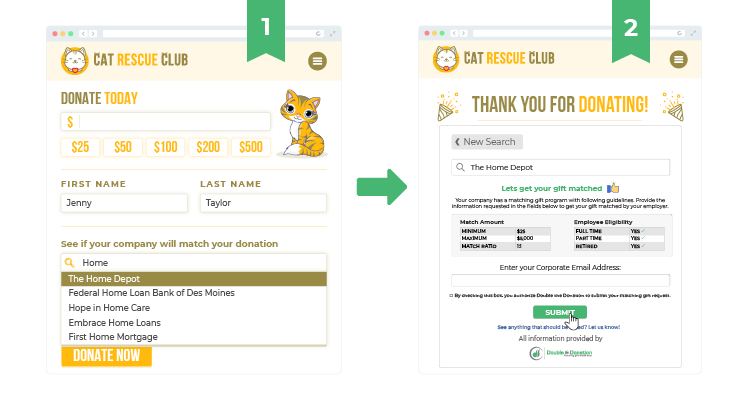
Let’s say you use a CSR platform that integrates with our matching gift auto-submission feature. When one of your employees donates to a nonprofit that uses Double the Donation, the donor can click a checkbox to opt into auto-submission on the nonprofit’s digital donation form. Our tools will automatically fill out their request and submit it to your company. No need for them to fill out a separate form! Our goal is to make it easy for employees to participate in workplace giving and for nonprofits to receive much-needed revenue to power their causes.
Check out this video to see an in-depth demonstration of how the tools work with corporate giving software:
When the entire process takes mere seconds and doesn’t involve the user leaving their current page on the organization’s website, they’ll be more likely to take part—and your company will reap the benefits of them doing so!
Additional Workplace Giving Resources
Ready to empower your business and its employees to do good in the world? Workplace giving is the way to go—and you’re all set to put these practices into action and begin making a change.
We recommend starting with two of the most popular forms of philanthropy by far: matching gifts and volunteer grants! Your employees will be increasingly engaged and proud to support your company, nonprofits will benefit from your generous corporate donations, and you’ll see elevated brand reputation and sales—which are all good for your bottom line.
Read up on top corporate philanthropy tips and strategies with our other educational guides:
- Making CSR More Than Just a Marketing Initiative. Corporate social responsibility can bring excellent marketing benefits to participating companies—but the advantages run much deeper. Find out what CSR can do for your company in this blog post.
- How To Offer the Ultimate Employee Giving Experience. Boosting employee and workplace giving participation (and the benefits you see from these efforts) depends on team members’ experiences with the programs. Here’s how to offer the best possible!
- 7 Employee Engagement Ideas to Promote Philanthropy. Corporate philanthropy and employee engagement tend to go hand in hand. Check out these seven suggestions for companies aiming to engage employees while pursuing the greater good.
